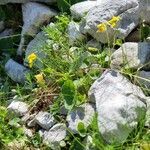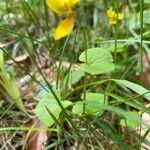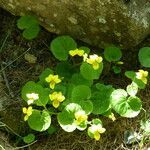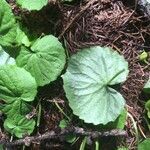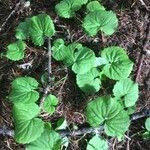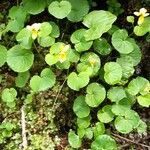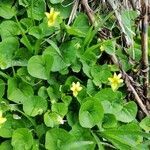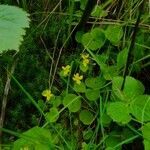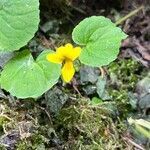Plants perennial, caulescent, not stoloniferous, 3–20(–25) cm. Stems 1–3+, ascending or erect, leafy proximally and distally, glabrous, on caudex from fleshy rhizome. Leaves basal and cauline; basal: 2–3(–4); stipules ovate-lanceolate, ovate, or oblong, margins entire, apex ± acute; petiole 1.5–15 cm, glabrous; blade broadly reniform to orbiculate, 0.5–4.6 × 0.9–6.4 cm, base cordate, margins crenate to crenate-serrate, ciliate, apex obtuse, rounded, or truncate, rarely with terminal point, abaxial surface sparsely puberulent on veins, adaxial surface glabrate to ± densely puberulent; cauline similar to basal except: stipules lanceolate, ovate, or oblong, margins entire to erose, apex acute to obtuse; petiole 0.3–7(–10) cm; blade sometimes ovate, 0.8–3.7 × 1–4.8 cm. Peduncles 2–9 cm, usually glabrous. Flowers: sepals with or without purple stripe on both sides of midvein, narrowly lanceolate to oblong, margins ciliate or eciliate, auricles 0.5–1 mm; petals deep lemon-yellow on both surfaces, lower 3 and often upper 2 brownish purple-veined, lateral 2 beardless, lowest 6–15 mm, spur yellow to yellowish green, gibbous, 2–2.5 mm; style head beardless; cleistogamous flowers axillary. Capsules oblong-ovoid, 3–6 mm, glabrous or sparsely pubescent. Seeds purple, sometimes streaked with light and dark brown, 1.5–2.5 mm.
Perennial; rhizome horizontal or oblique, more or less stout, roots on lower surface, leaves and stems at apex. Stems up to 8 cm, slender, ascending to erect, with leaves along their length and flowers distally. Leaves ¾-1¼ by 1-2½ cm, 1¼-2times as broad as long, reniform to broadly ovate, more or less deeply cordate, rounded to broadly obtuse, subcrenate to repand-dentate, especially on lobes, subcoriaceous, glabrous beneath, sparsely hirsute towards margins and on veins above, dark green; petiole ½-5 cm, slender. Stipules 2-4 by 2-3 mm, ovate, acute, entire to sparsely denticulate, glabrous, fuscous, free. Flowers 8-12 mm, yellow with brownish-purple veins; peduncle 1.4-8 cm, much exceeding leaves, slender. Sepals 3-4 by c. 1 mm, linear to linear-oblong, acute, glabrous or shortly ciliate on margin, fuscous, with margin scarious; appendage up to ½ mm, rounded, glabrous. Petals 2-3 times as long as broad, obovate to almost oblong, basal exceeding the others, laterals not bearded; spur 1-1½ mm, cylindrical, obtuse. Style 1.2-1½ mm, slightly geniculate at base, clavate distally, apex with 2 lateral lobes fused behind, no stigmatic beak. Capsule 4-6 mm, oblong to ellipsoid, glabrous.
A herb. It grows 10-20 cm high and spreads 15-25 cm wide. It forms mounds. The leaves have shallow teeth and are faintly downy. The leaves are heart or kidney shaped. They are 30 mm long. The flowers are pale yellow with dark streaks. They are 18 mm wide.
